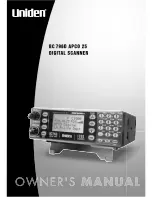
distant transmitters on the same channel. In all major metropolitan areas of the United States, every available radio channel is assigned to more than one
user. Public safety radio systems on the same frequency are usually set up at a distance of 40 miles apart, or more. This means that you may hear
transmissions from a distant system when your local system is not transmitting. By programming the code (or tone) for a local channel the scanner will not
stop on transmissions from the distant system.
With few exceptions, such as the VHF Aircraft and Marine bands, almost every other VHF or UHF radio system uses some form of coded squelch. By far,
CTCSS is the most popular mode among non-trunked systems. Usually, but not always, VHF channels will use CTCSS and UHF channels will use DCS.
P25 (digital) conventional channels will use only NAC. NAC, similar to CTCSS/DCS, has a 3 digit hexadecimal code that can be broadcast along with the
digital signal being transmitted.
For more information visit Radio Reference's respective pages on
,
Turning On The Scanner And Setting the Squelch
Make sure the scanner's antenna is connected before you turn it on.
1. Turn the
VOL
and
SQ
knobs clockwise to about the 9:00 o'clock position.
2. Press
TUNE
3. Turn
SQ
down (counterclockwise) until you hear noise.
4. Turn
SQ
up (clockwise) a little past where the noise stops. The higher the squelch
is set, the stronger the signal required to break the squelch.
5. If noise starts breaking the squelch, turn
SQ
up to decrease the scanner's
sensitivity. To hear weaker signals, turn
SQ
down to increase its sensitivity.
6. Press
SCAN
to scan or
PGM
to begin programming.
A Look at the Keypad
Your scanner's keys might seem confusing at first, but this information should help you understand each key's function.
Key
Function(s)
F1,F2,F3
Soft keys that select the function in the display directly above each key.
FUNC-F1
Used to access the
F1
key during transmissions in search modes
(overrides
FrL/O
for
Band
and
Lmts
).
◄
►
Used to navigate menus and scan lists.
▼
▲
Used to navigate menus and objects in scan lists.
SEL (Select)
Enters sub-menus for objects.
Selects/de-selects scan lists in object menus; same as
ENT
(enter).
Exits help menu.
FUNC-SEL
Brings up help menu for selected menu item.
FUNC
In text mode toggles capital/small letters; 1st and 2nd set of characters.
(HH) Turns the backlight off/on in
normal mode
.
FUNC-
(HH) Locks/unlocks the keypad.
DIM
(Base) Toggles the display brightness.
MAN
(Manual)
Allows you to navigate to and monitor single objects including search
objects. Recalls last tuned object.
SCAN/
/
Scans the enabled scan lists.
FUNC-SCAN
Starts dedicated Signal Stalker/Spectrum Sweeper search.
TUNE
Starts a 'Tune' search.
FUNC-TUNE
Starts a 'Tune' search at the current or most recently tuned frequency.
SRCH
(Search)
Selects dedicated service searches and the dedicated limit search.
ATT
(Attenuator)
Toggles the attenuator on/off for a specific object in manual or pause
modes.
Toggles the global
on/off in scan and search modes.
FUNC-ATT
Toggles the
global attenuator
on/off in scan and search modes.
PRI
(Priority)
Toggles priority setting on/off for a specific object or weather channel.
FUNC-PRI
Toggles priority mode on/off.
FAV
(Favorites)
Scans the Favorites (only) scan list.
FUNC-FAV
Adds the displayed object to the Favorites scan list.
WX/
Enters weather scan mode.
FUNC-WX/
Scans the Skywarn (only) scan list.
PGM
(Program)
Enters program mode for editing radio-wide options, adding new objects or
editing existing objects.
FUNC-
PGM(VS)
Enters V-Scanner mode.
L/OUT
Locks or temporarily locks out an object (depending on the
setting
of the
button).
FUNC-
L/OUT
Locks or temporarily locks out an object (depending on the
setting
of the
button).
ENT (Enter)
Enters sub-menus for objects. Saves text and numbers when
programming.
Selects/de-selects scan lists in object menus; same as
SEL
(select).
Pro 106/651 Keypad
PSR 600 Keypad






































